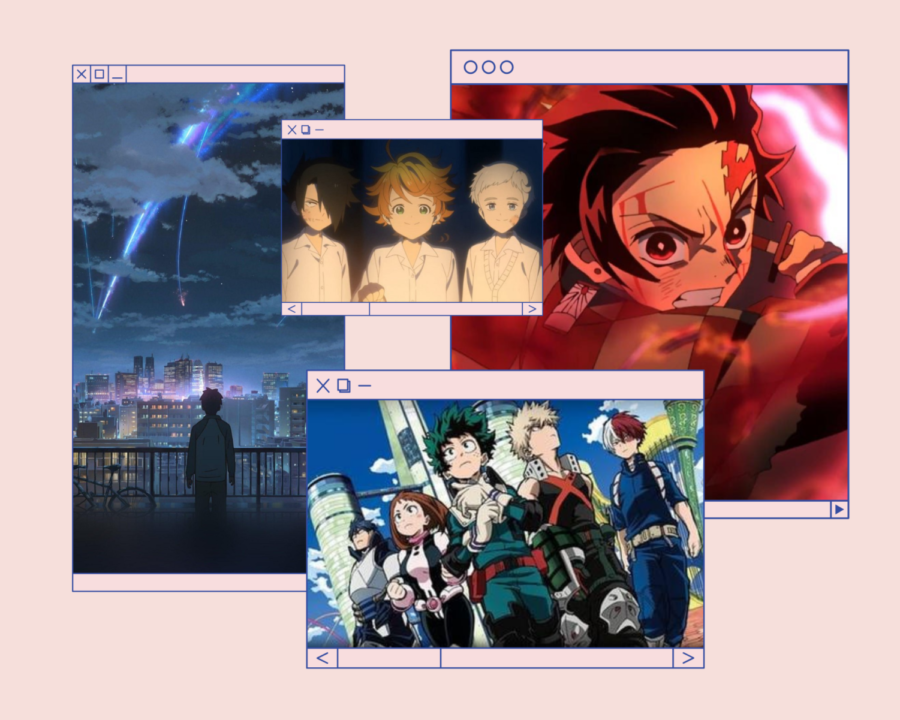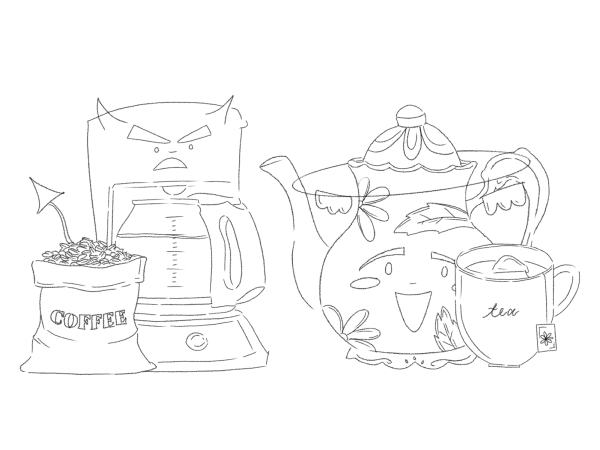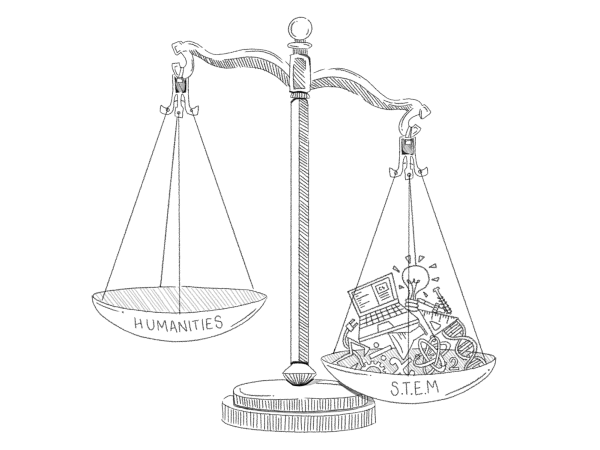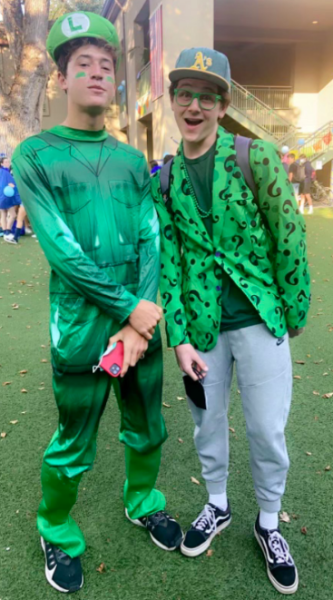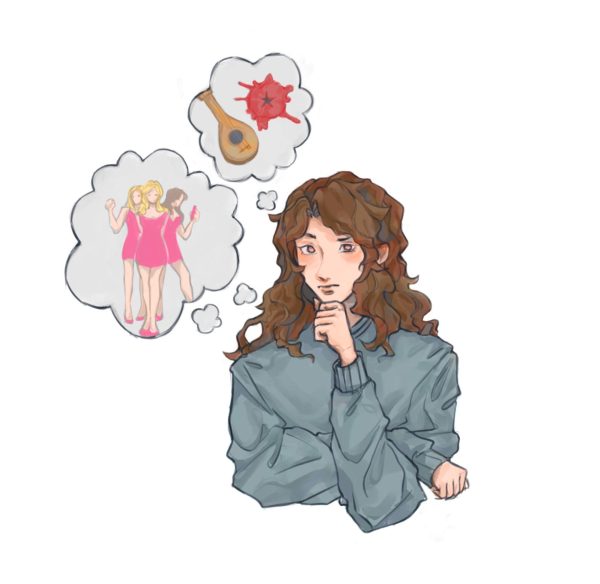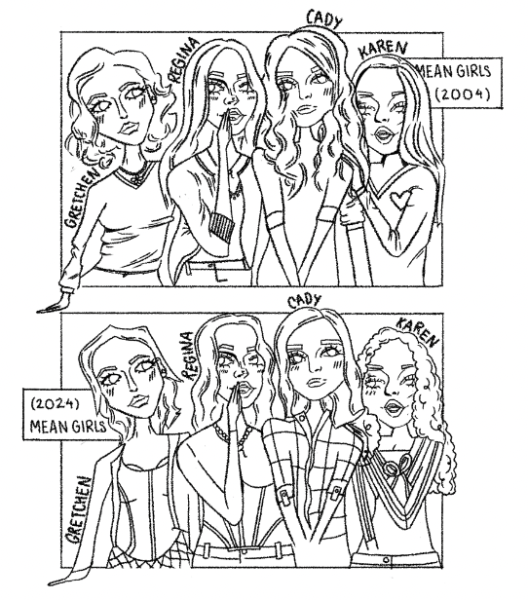The Power of Anime Can Transform America’s English Classrooms
While anime has surged in popularity in recent years, its uses go beyond a hobby. Illustration by Mitsuka Kiyohara.
December 4, 2021
Wind blowing at the most climactic moment, lethal injuries that somehow aren’t deadly and waking up in an alternate world could only mean one thing: Anime.
Anime has garnered millions of viewers worldwide and has become deeply ingrained in the Japanese lifestyle, according to the Wall Street Journal. I grew up watching the “PreCure” series on TV every day after school, like the female version of “The Power Rangers.” I endlessly dreamt of being one of the heroines in the show who would save the world and uplift others with my tenacious spirit. However, when I was around ten years old, I gradually stopped watching anime. I fled because I simply couldn’t see the value behind it. Whenever I heard someone say that they watched anime, I felt humiliated for them. Anime looked immature. A picture gallery of young girls playing dumb and overly passionate boys crying would play on a never-ending repeat in my head. Despite having countless family members and friends who casually watched anime, I made a determined effort to distance myself from being an anime viewer and instead conformed to watching American television.
Two years ago, when I fell into an emotional depression, I had struggled to escape from a dark, mental abyss. For what felt like an eternity, I drowned myself under the waters of despondency and dissatisfaction. I didn’t know how to swim out of the situation nor spot a ladder to pull me out. Then, one late night, a random careless idea came across me. I watched on my own a shonen anime called “My Hero Academia.” A shonen anime is a type of genre in anime largely targeted towards younger teen males, commonly featuring a male protagonist.
The show follows a young boy working his way towards being the number one hero. Although I had watched the show as a means to waste time, I hadn’t registered that this clumsy, nerdy protagonist with overwhelming drive and passion got me leaning over my laptop screen. Fascinated with the protagonist’s character, I ended the night binging through the entire show. I stared in silence, eyes brimming with tears of relief and comfort. An answer in overcoming my slump was not what I anticipated. I watched this show when I lacked self-confidence in myself. When I witnessed the progression of the main character grow to a real aspiring hero, it made me realize that merit does not indicate one’s worth. People have their talents and quirks that make them valuable to our world and recognizing those aspects can pull us up from the dark pit of hopelessness. “My Hero Academia” was the key that unlocked the door to my dark abyss and shone a bright light towards my helpless body.
Anime is commonly associated with being just a hobby, something that is watched with friends or late at night in the safety of bed. However, underneath the vivid graphics and childlike comedy underlies a larger purpose as a medium for storytelling and teaching critical reading skills. Bringing anime into the English classrooms can provide an opportunity to bring conventional hobbies of entertainment into the limelight, validating their need. The ornate animation and complexity of anime make it a useful tool to teach students about solutions to predicaments and some of the dark realities in the world in an entertaining format.
For example, “Demon Slayer,” one of Japan’s blockbuster anime series, teaches one to build complex, nuanced views of difficult situations; within the realm of man-eating demons, standing in the enemy’s shoes becomes key in the character development of the main protagonist and the viewer’s understanding of the show’s complexity. The story unfolds in Japan a hundred years ago (during the Taisho period), where a young boy fights to help his younger sister transform back to a human. He makes various, dire efforts to communicate with the demons to find a cure. It seems that he is the only character in the show who desperately seeks to understand the values the demons hold. But by doing so, he is the only character whose empathy gives them their humanity back, even in their dying moments. While the world of “Demon Slayer” is divided into two radically distinct values, through the protagonist’s acute strive to fill the gap, the broader implication of the animation is addressing the necessity of thinking and understanding views from outside perspectives.
In Chimamanda Ngozi Adichie’s influential TED Talk, “The Danger of the Single Story,” she argues that single stories have an inherent danger of knowing only one story about a group and encourages the audience to recognize the significance of stories to help humanize others. Similarly, the show encourages audience members to do the same by animating each demon’s backstories that the protagonist faces, which proves relevant today. In a polarized America, it feels nearly impossible to see eye to eye without disparaging one another. A label of value that we give ourselves automatically marks someone as an enemy, which has been the fundamental cause in our current polarized state. As of today, there hasn’t been a model America could learn from in discovering common ground. However, “Demon Slayer” presents itself as an example that can help fill the gap in our nation and a relevant lesson for future generations.
In “The Promised Neverland,” where red herrings and plot holes scatter through the script, the author Kaiu Shirai trains the viewers and the characters to infer, striving for truth and uncovering deception. The show is a dark fantasy thriller in which children raised in an orphanage must meet the harsh destiny that awaits them. It captures the hearts of audiences with its unique narrative, metaphorical societal themes. The anime harbors many secrets and mysteries unexplained to the characters and the audience. What is real? What is false? Who’s truthful? Who’s the hidden enemy? These are questions that the protagonists and audience must answer together. In an anime full of deception, there is no room for the viewer to relax; every dialogue and drawn detail purports a clue in unraveling the mystery. Therefore, it makes the audience infer alongside the main characters from the limited clues they are given. Recent studies of text grammar show that inferences play a significant role in reading comprehension and critical reading. The ability to draw inferences from reading or listening develops from early childhood to adulthood and is closely linked to background experience. “The Promised Neverland” seamlessly exercises this crucial reading skill in their narrative and teaches us the danger of surface-level reading. It succeeds in reminding us of the need of making decisions through reasoning, which is highly relevant to today’s contended topics such as fake news and privacy.
Anime has continuously been evolving, and its universe has skyrocketed with the rise in the availability of anime online. Shounen anime like “Demon Slayer” and “The Promised Neverland” teaches viewers to be insightful in a self-explanatory, entertaining format. Therefore, not all anime are slice-of-life or childish cartoons. Within this genre, great animes worthy of further analysis exist, serving as an artistic medium for storytelling in a way other narrative mediums cannot because of its comedic, fun addition and knowledge retention. Great anime can help us find solutions to our predicaments and learn about some of the dark realities in the world in an entertaining format.
It’s also been more than fifty years since literary experts first stressed the need for more diverse artistic works in English classrooms; however, many schools continue to read and analyze the same texts as students did in 1970, according to Jill Anderson’s book “Hooked on Classics.” Many students miss an entire realm of global literature rich with analysis and knowledge, limiting students from understanding the world around them. However, at Menlo, Oscar King’s Contemporary Global Literature class offers a challenge for students to “understand how global art forms not only reflect social values and norms but also challenge and reconstitute them.” As I found meaning in anime and expanding conventional teaching material to include global works like anime, we can promote a breakthrough in English education for future generations, producing students with a new, profound emphasis on open-mindedness.


